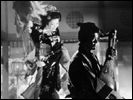Crest of Betrayal
- Year
- 1994
- Original title
- Chushingura Gaiden Yotsuya Kaidan
- Japanese title
- 忠臣蔵外伝 四谷怪談
- Director
- Cast
- Running time
- 106 minutes
- Published
- 17 July 2001

by Tom Mes
One of the most enduring sagas in Japanese cinema is the story of Chushingura, or the 47 ronin. The true-life tale of 47 samurai warriors banding together to assassinate the ruler responsible for the death of their master has been subject of films as diverse as Hiroshi Inagaki's lavish The Loyal 47 Ronin (Chushingura, 1962) to Masamu Tsushima's cheerfully trashy Ninja Vixens (Kunoichi Ninpo-cho IV: Chushingura Hisho, 1994). Kinji Fukasaku had done his own version in the late seventies, under the title The Fall of Ako Castle (Ako-jo Danzetsu, 1978), a sequel to Shogun's Samurai (Yagyu Ichizoku no Inbo, 1978), the director's first attempt at making a jidai geki after two decades of mainly contemporary crime and gangster films.
For Crest of Betrayal, Fukasaku and co-screenwriter Motomu Furuta combined the legend of the forty-seven samurai with another stalwart of Japanese folklore: the ghost story of Yotsuya. Most famously brought to the screen by Jigoku director Nobuo Nakagawa in 1959's Tokaido Yotsuya Kaidan, the ghost story of Yotsuya concerns the revenge of a disfigured female ghost on her lover, who had poisoned her in order to marry a woman of better standing. Despite often having been combined on stage, Crest of Betrayal is the first cinematic attempt at weaving the two folktales into a single story.
Interestingly, for a film with such a historic pedigree Crest of Betrayal is very contemporary in its themes. Even though it is set in the early 18th century, the society portrayed in the film is very much reminiscent of Japan in the 1990s: a once-prosperous economy in decline, shifting morals, an increasing individualism. Central character in this story is Iemon, one of the 47 samurai who was left masterless after the forced suicide of his lord. With his fellow warriors he plots revenge on the culprit Yoshinaga, but in the meantime he tries to scrape together a living as a mercenary and a musician (he plays the traditional string instrument, the biwa). Iemon becomes involved with Oiwa, a prostitute he meets at a bath house, but not longer thereafter he is himself courted by the granddaughter of a rich nobleman from the clan of Yoshinaga. Yoshinaga may be his enemy, but he is also a rich and powerful man and marrying into his circle will be Iemon's ticket out of a life of misery and dishonour. Iemon abandons his comrades and decides to get rid of Oiwa by poisoning her. The poison, brewed by the confidentes of his bride-to-be, puts Oiwa through horrible pains and dramatically disfigures her face before finally killing her. But on their wedding night, the ghost of Oiwa comes to haunt the young couple. Time and again she appears to Iemon, until she finally drives him insane and sends him on a murderous rampage against his in-laws.
In Crest of Betrayal, Fukasaku focuses strongly on Iemon's individualist nature. A once-proud man, his poverty-stricken situation causes him to betray his morals and search for some kind of guarantee of an economically sound future and a way out of the ruts. By putting this character against the background of a dwindling economy, Fukasaku is obviously drawing parallels to Japan's economic and social state in the mid-1990s. In his best films, the director has always sought to question the developments he saw in society around him. Examples run from the early Wolves, Pigs and Men (Okami to Buta to Ningen, 1964) to his controversial hit Battle Royale (2000). Although it takes the guise of a period costume drama, Crest of Betrayal adheres to Fukasaku's filmmaking philosophy and becomes all the better because of it. It's one of those films which works both ways: as masqueraded social commentary or as a genre-traversing period piece. Choose either one or both, you can't fail to be entertained and impressed. Beautifully photographed with striking, dreamlike images, Crest of Betrayal is Kinji Fukasaku in terrific form.